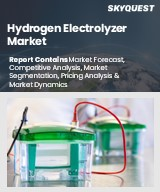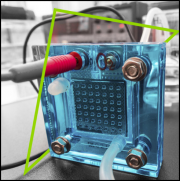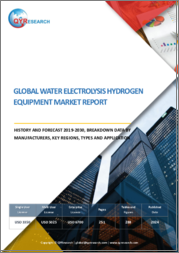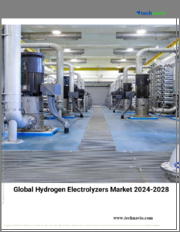
|
시장보고서
상품코드
1772658
수소 전해조 시장 규모, 점유율, 성장 분석 : 제품 유형별, 용량별, 출구 압력별, 최종 용도별, 지역별 - 산업 예측(2025-2032년)Hydrogen Electrolyzer Market Size, Share, and Growth Analysis, By Product Type, By Capacity (Low, Medium ), By Outlet Pressure, By End Use, By Region - Industry Forecast 2025-2032 |
||||||
세계의 수소 전해조 시장 규모는 2023년에 5억 2,000만 달러로 평가되며, 2024년 7억 9,000만 달러에서 2032년까지는 215억 2,000만 달러로 성장하며, 예측 기간(2025-2032년)의 CAGR은 51.23%로 성장할 전망입니다.
세계의 수소 전해조 시장은 규제 지원, 기술 발전, 재생에너지와의 시너지 효과 강화에 힘입어 크게 성장하고 있습니다. 각국 정부는 청정 에너지로의 전환을 강화하기 위해 엄격한 정책을 제정하고 인센티브를 제공하고 있으며, 그 결과 수소 인프라에 대한 민관 투자가 크게 증가하고 있습니다. 수소전기자동차는 재생에너지로부터 그린 수소를 생산하는 데 중요한 역할을 하며, 이러한 전환을 촉진하는 데 중요한 역할을 하고 있습니다. 지속적인 기술 혁신은 효율성 향상, 비용 절감, 확장성 향상을 통해 시장 잠재력을 높이고 있습니다. 이러한 발전은 운송, 산업 공정, 에너지 저장 등 다양한 분야에서 수소 제조를 더욱 현실적으로 만들고 있습니다. 또한 수소 생산과 재생에너지(특히 풍력 및 태양광)와의 원활한 통합은 시장 확대의 중요한 촉매제 역할을 할 수 있습니다.
목차
서론
- 조사의 목적
- 조사 범위
- 정의
조사 방법
- 정보 조달
- 2차와 1차 데이터 방법
- 시장 규모 예측
- 시장의 전제조건과 제한
개요
- 세계 시장 전망
- 공급과 수요 동향 분석
- 부문별 기회 분석
시장 역학과 전망
- 시장 개요
- 시장 규모
- 시장 역학
- 촉진요인과 기회
- 억제요인과 과제
- Porter의 산업 분석
주요 시장 인사이트
- 주요 성공 요인
- 경쟁의 정도
- 주요 투자 기회
- 시장 에코시스템
- 시장의 매력 지수(2024년)
- PESTEL 분석
- 거시경제 지표
- 밸류체인 분석
- 가격 분석
- 규제 분석
세계의 수소 전해조 시장 규모 : 제품 유형별·CAGR(2025-2032년)
- 시장 개요
- 양성자 교환막 전해조
- 알칼리 전해조
- 고체 산화물 전해조
세계의 수소 전해조 시장 규모 : 용량별·CAGR(2025-2032년)
- 시장 개요
- 저(150kW 이하)
- 중(150kW-1mW)
- 150-400kW
- 400-750kW
- 750-1mW
- 고(1mW 초과)
- 1-10mW
- 10-20mW
- 20mW 이상
세계의 수소 전해조 시장 규모 : 출구 압력별·CAGR(2025-2032년)
- 시장 개요
- 저(10Bar 이하)
- 중(150Bar-40Bar)
- 고(40Bar 초과)
세계의 수소 전해조 시장 규모 : 최종 용도별·CAGR(2025-2032년)
- 시장 개요
- 암모니아
- 메탄올
- 정제/탄화수소
- 일렉트로닉스
- 에너지
- P2G(Power to Gas)
- 운송
- 금속 생산·가공
- 제약·바이오테크놀러지
- 식품 및 음료
- 유리 산업
- 기타 산업
세계의 수소 전해조 시장 규모·CAGR(2025-2032년)
- 북미
- 미국
- 캐나다
- 유럽
- 독일
- 스페인
- 프랑스
- 영국
- 이탈리아
- 기타 유럽 지역
- 아시아태평양
- 중국
- 인도
- 일본
- 한국
- 기타 아시아태평양
- 라틴아메리카
- 브라질
- 기타 라틴아메리카 지역
- 중동 및 아프리카
- GCC 국가
- 남아프리카공화국
- 기타 중동 및 아프리카
경쟁 정보
- 상위 5사의 비교
- 주요 기업의 시장 포지셔닝(2024년)
- 주요 시장 기업이 채택한 전략
- 최근 시장 동향
- 기업의 시장 점유율 분석(2024년)
- 주요 기업의 기업 개요
- 기업의 상세
- 제품 포트폴리오 분석
- 기업의 부문별 점유율 분석
- 매출의 전년대비 비교(2022-2024년)
주요 기업 개요
- Siemens Energy(Germany)
- Thyssenkrupp Nucera(Germany)
- John Cockerill(Belgium)
- Plug Power Inc.(USA)
- ITM Power PLC(UK)
- McPhy Energy S.A.(France)
- Enapter S.r.l.(Italy)
- Cummins Inc.(USA)
- Ballard Power Systems Inc.(Canada)
- LONGi(China)
- PERIC Hydrogen Technologies Co., Ltd.(China)
- Green Hydrogen Systems(Denmark)
- Sunfire GmbH(Germany)
- Bloom Energy(USA)
- HydrogenPro(Norway)
- H-TEC SYSTEMS GmbH(Germany)
- Asahi Kasei Corporation(Japan)
- Beijing SinoHy Energy Co., Ltd.(China)
- Giner Inc.(USA)
결론과 제안
KSA 25.07.23Global Hydrogen Electrolyzer Market size was valued at USD 0.52 billion in 2023 and is poised to grow from USD 0.79 billion in 2024 to USD 21.52 billion by 2032, growing at a CAGR of 51.23% during the forecast period (2025-2032).
The global hydrogen electrolyzer market is witnessing substantial growth fueled by regulatory support, technological advancements, and enhanced synergy with renewable energy sources. Governments worldwide are enacting strict policies and providing incentives to bolster the shift towards clean energy, resulting in significant public and private investments in hydrogen infrastructure. Hydrogen electrolyzers play a crucial role in generating green hydrogen from renewable sources, positioning themselves as key drivers of this transition. Continuous technological innovations enhance market potential through improved efficiency, reduced costs, and greater scalability. These advancements make hydrogen production more viable across various applications, including transportation, industrial processes, and energy storage. Additionally, the seamless integration of hydrogen production with renewable energy, particularly wind and solar, serves as a vital catalyst for market expansion.
Top-down and bottom-up approaches were used to estimate and validate the size of the Global Hydrogen Electrolyzer market and to estimate the size of various other dependent submarkets. The research methodology used to estimate the market size includes the following details: The key players in the market were identified through secondary research, and their market shares in the respective regions were determined through primary and secondary research. This entire procedure includes the study of the annual and financial reports of the top market players and extensive interviews for key insights from industry leaders such as CEOs, VPs, directors, and marketing executives. All percentage shares split, and breakdowns were determined using secondary sources and verified through Primary sources. All possible parameters that affect the markets covered in this research study have been accounted for, viewed in extensive detail, verified through primary research, and analyzed to get the final quantitative and qualitative data.
Global Hydrogen Electrolyzer Market Segments Analysis
Global Hydrogen Electrolyzer Market is segmented by Product Type, Capacity, Outlet Pressure, End Use and region. Based on Product Type, the market is segmented into Proton Exchange Membrane Electrolyzer, Alkaline Electrolyzer and Solid Oxide Electrolyzer. Based on Capacity, the market is segmented into Low (<= 150 kW), Medium (150kW - 1mW) and High (> 1mW). Based on Outlet Pressure, the market is segmented into Low (<= 10 Bar), Medium (150 Bar - 40 Bar) and High (> 40 Bar). Based on End Use, the market is segmented into Ammonia, Methanol, Refining/ Hydrocarbon, Electronics, Energy, Power to Gas, Transport, Metal Production and Fabrication, Pharma and Biotech, Food and Beverages, Glass Industry and Other Industrial. Based on region, the market is segmented into North America, Europe, Asia Pacific, Latin America and Middle East & Africa.
Driver of the Global Hydrogen Electrolyzer Market
The growing emphasis on minimizing carbon emissions is significantly fueling the demand for green hydrogen, which is generated through hydrogen electrolyzers that utilize renewable energy sources. Both governments and industries around the globe are channeling investments into extensive green hydrogen initiatives to facilitate decarbonization across various sectors, including transportation, power generation, and industrial manufacturing. Additionally, the introduction of incentives, subsidies, and supportive policies aimed at advancing clean energy transitions is further propelling the uptake of hydrogen electrolyzers. This shift towards sustainable energy solutions is essential in addressing climate change and promoting a cleaner future.
Restraints in the Global Hydrogen Electrolyzer Market
The global hydrogen electrolyzer market faces substantial challenges due to the high costs associated with establishing the necessary infrastructure. The financial burden of acquiring electrolyzer units, alongside the complexities involved in integrating these systems with renewable energy sources, creates a barrier to widespread adoption. This, coupled with ongoing maintenance expenses, significantly hinders market growth, particularly in developing regions where budget constraints are more pronounced. As a result, potential users may be deterred from investing in hydrogen electrolyzers, slowing the transition towards cleaner energy solutions and limiting the overall expansion of the market.
Market Trends of the Global Hydrogen Electrolyzer Market
The Global Hydrogen Electrolyzer market is witnessing a significant upward trend, driven by the expansion of large-scale green hydrogen projects. As nations worldwide intensify their commitment to clean energy, the integration of electrolyzers with renewable energy sources, particularly solar and wind, is becoming pivotal. Countries such as Germany, Australia, and Saudi Arabia are spearheading the development of massive hydrogen hubs, positioning themselves as future leaders in hydrogen production and export. This surge in investment and technological advancement not only enhances hydrogen production efficiency but also facilitates competitive pricing, ultimately fostering a robust ecosystem centered around green hydrogen solutions.
Table of Contents
Introduction
- Objectives of the Study
- Scope of the Report
- Definitions
Research Methodology
- Information Procurement
- Secondary & Primary Data Methods
- Market Size Estimation
- Market Assumptions & Limitations
Executive Summary
- Global Market Outlook
- Supply & Demand Trend Analysis
- Segmental Opportunity Analysis
Market Dynamics & Outlook
- Market Overview
- Market Size
- Market Dynamics
- Drivers & Opportunities
- Restraints & Challenges
- Porters Analysis
- Competitive rivalry
- Threat of substitute
- Bargaining power of buyers
- Threat of new entrants
- Bargaining power of suppliers
Key Market Insights
- Key Success Factors
- Degree of Competition
- Top Investment Pockets
- Market Ecosystem
- Market Attractiveness Index, 2024
- PESTEL Analysis
- Macro-Economic Indicators
- Value Chain Analysis
- Pricing Analysis
- Regulatory Analysis
Global Hydrogen Electrolyzer Market Size by Product Type & CAGR (2025-2032)
- Market Overview
- Proton Exchange Membrane Electrolyzer
- Alkaline Electrolyzer
- Solid Oxide Electrolyzer
Global Hydrogen Electrolyzer Market Size by Capacity & CAGR (2025-2032)
- Market Overview
- Low (<= 150 kW)
- Medium (150kW - 1mW)
- 150 - 400 kW
- 400 - 750kW
- 750 - 1mW
- High (> 1mW)
- 1 - 10 mW
- 10 - 20 mW
- Above 20 mW
Global Hydrogen Electrolyzer Market Size by Outlet Pressure & CAGR (2025-2032)
- Market Overview
- Low (<= 10 Bar)
- Medium (150 Bar - 40 Bar)
- High (> 40 Bar)
Global Hydrogen Electrolyzer Market Size by End Use & CAGR (2025-2032)
- Market Overview
- Ammonia
- Methanol
- Refining/ Hydrocarbon
- Electronics
- Energy
- Power to Gas
- Transport
- Metal Production and Fabrication
- Pharma and Biotech
- Food and Beverages
- Glass Industry
- Other Industrial
Global Hydrogen Electrolyzer Market Size & CAGR (2025-2032)
- North America (Product Type, Capacity, Outlet Pressure, End Use)
- US
- Canada
- Europe (Product Type, Capacity, Outlet Pressure, End Use)
- Germany
- Spain
- France
- UK
- Italy
- Rest of Europe
- Asia Pacific (Product Type, Capacity, Outlet Pressure, End Use)
- China
- India
- Japan
- South Korea
- Rest of Asia-Pacific
- Latin America (Product Type, Capacity, Outlet Pressure, End Use)
- Brazil
- Rest of Latin America
- Middle East & Africa (Product Type, Capacity, Outlet Pressure, End Use)
- GCC Countries
- South Africa
- Rest of Middle East & Africa
Competitive Intelligence
- Top 5 Player Comparison
- Market Positioning of Key Players, 2024
- Strategies Adopted by Key Market Players
- Recent Developments in the Market
- Company Market Share Analysis, 2024
- Company Profiles of All Key Players
- Company Details
- Product Portfolio Analysis
- Company's Segmental Share Analysis
- Revenue Y-O-Y Comparison (2022-2024)
Key Company Profiles
- Siemens Energy (Germany)
- Company Overview
- Business Segment Overview
- Financial Updates
- Key Developments
- Thyssenkrupp Nucera (Germany)
- Company Overview
- Business Segment Overview
- Financial Updates
- Key Developments
- John Cockerill (Belgium)
- Company Overview
- Business Segment Overview
- Financial Updates
- Key Developments
- Plug Power Inc. (USA)
- Company Overview
- Business Segment Overview
- Financial Updates
- Key Developments
- ITM Power PLC (UK)
- Company Overview
- Business Segment Overview
- Financial Updates
- Key Developments
- McPhy Energy S.A. (France)
- Company Overview
- Business Segment Overview
- Financial Updates
- Key Developments
- Enapter S.r.l. (Italy)
- Company Overview
- Business Segment Overview
- Financial Updates
- Key Developments
- Cummins Inc. (USA)
- Company Overview
- Business Segment Overview
- Financial Updates
- Key Developments
- Ballard Power Systems Inc. (Canada)
- Company Overview
- Business Segment Overview
- Financial Updates
- Key Developments
- LONGi (China)
- Company Overview
- Business Segment Overview
- Financial Updates
- Key Developments
- PERIC Hydrogen Technologies Co., Ltd. (China)
- Company Overview
- Business Segment Overview
- Financial Updates
- Key Developments
- Green Hydrogen Systems (Denmark)
- Company Overview
- Business Segment Overview
- Financial Updates
- Key Developments
- Sunfire GmbH (Germany)
- Company Overview
- Business Segment Overview
- Financial Updates
- Key Developments
- Bloom Energy (USA)
- Company Overview
- Business Segment Overview
- Financial Updates
- Key Developments
- HydrogenPro (Norway)
- Company Overview
- Business Segment Overview
- Financial Updates
- Key Developments
- H-TEC SYSTEMS GmbH (Germany)
- Company Overview
- Business Segment Overview
- Financial Updates
- Key Developments
- Asahi Kasei Corporation (Japan)
- Company Overview
- Business Segment Overview
- Financial Updates
- Key Developments
- Beijing SinoHy Energy Co., Ltd. (China)
- Company Overview
- Business Segment Overview
- Financial Updates
- Key Developments
- Giner Inc. (USA)
- Company Overview
- Business Segment Overview
- Financial Updates
- Key Developments

















